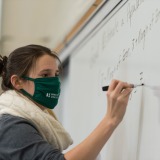
While we practice using contingency tables and finding probabilities, we are looking at the issue of constitutionality and racial profiling in the practice.
By Jordan Costa ‘21
Discussions around themes of social justice are everywhere, including Professor Catherine Buell’s applied statistics class.
Math can be understood in many different ways and using real-world situations can help students better grip the material at hand. Using social justice situations can put into perspective not only these important issues but also help them put real-world examples to their math terminology, said Buell, who has taught the course - which was developed by faculty members from across disciplines - since 2016.
Buell said students connect better with the math when adding current situations and issues to the material.
“For example, when we study probability we use data from the New York Police Department’s ‘Stop and Frisk’ program,” said Buell, referring to the controversial police tactic in which young men of color were disproportionately targeted by police. “While we practice using contingency tables and finding probabilities, we are looking at the issue of constitutionality and racial profiling in the practice.”
The mathematical concepts of the course are similar to other statistics classes on campus, but are illustrated with examples based on social justice topics rather than just random sample data. Some of the math goals that are achieved in this class include understanding statistical communication, creating statistical information, and developing concepts such as common statistical vocabulary, measures of central tendency, measures of variation, p-values, confidence intervals, regression, t-tests, probability, and pattern description.
Buell’s objective for the course is to build students’ ability to seek, engage, and be informed by multiple perspectives. These objectives include recognizing the power of math as an essential analytical tool to understand the world and their own power as active citizens in building a democratic, equitable society.
Students are developing the ability to use critical inquiry and quantitative reasoning to identify a problem, research solutions, analyze results, evaluate choices, and make decisions, as well as becoming more motivated to understand and learn math while deepening their understanding of the interplay of social and economic issues like crime, victimization, political access, wealth, education, health, gender, and race.
“I've been able to connect to students through this course in ways I haven't always been able to in the past,” Buell said. “Some students have said they prefer studying statistics when it is contextualized in a topic that is meaningful for them. I've had students tell me it finally clicked when they were applying the statistics in these curated situations. I'm sure some students see it as a normal statistics class.”
Christi Pike ‘20 took the course with Professor Buell and said the social justice context was helpful.
“One of the first things I told Professor Buell was how much I despised math,” Pike said. “My whole life growing up I’ve been awful at math. The numbers just twisted my brain and I couldn't seem to do anything with them. When I took her class I was so excited because it was social justice and I was very interested in it, and once I was able to see the connection between social justice and math and statistics, it changed my entire view on math in general.”
Not only is this class allowing students to broaden their understanding of math and social justice topics but also opening up a space for discussion about these issues.
“Oddly, I’ve now taught this class twice in an election year,” Buell said. “There are so many statements and polls that offer good talking points to demonstrate what quantitative tools we need to be informed citizens.”
This article was originally published in the Winter 2021 edition of Contact magazine.